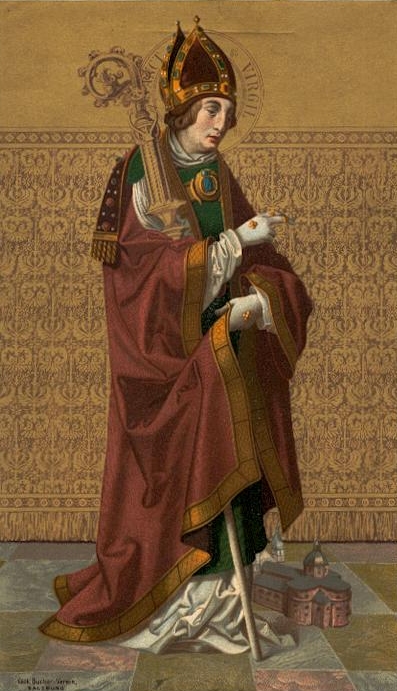
Image source: Virgil (Fergal)
Material source distilled from Omnium Sanctorum Hiberniae
St. Fergal (or Virgil) was a descendant of Niall of the Nine Hostages. He had mastered mathematics to the point of being considered a Geometer. He was an eight century Irish monk who became abbot of Aghaboe, in Co. Laoise, Ireland. In 743 he sojourned the Continent and became a voluntary exile for love of Jesus on his “Peregrini pro Christo”. Fergal had some companions; Dobda, an Irish Bishop, and Sidonius. In France Fergal met Prince Pippin the Short. The prince took to the learned monk and kept him in his palace for two years. From France Fergal moved to Bavaria where he founded the monastery of Chiemsee at the invitation of Duke Odilo, brother in law to Prince Pippin. As a missionary and an accomplished learner, Fergal stirred some contention with his contemporary missionary, Saint Boniface. Both of these saints evangelised the Germanic people of Bavaria.
The 1st contest between the Irish saint and St. Boniface
St. Boniface had already organized the Bavarian Church. He had created four dioceses in Bavaria. Boniface was a perfectionist, and took no prisoners if the clergy were seen to be unedifying to the faithful. For example, one unlettered priest under Fergal’s care, (out of ignorance) baptised in a Latin formula mixing up the words, translated from ‘’in the name of the Father, and of the Son…’’, to ‘’in the name of the Fatherland, and of the daughter’’. In Latin, the error is not extremely obvious, but Boniface, was scrupulous, declared the baptism invalid, and sought a rebaptism. Fergal was much more down to earth, and understanding of the human error. He saw that the unlearned priest pronounced the formula in error without bad intentions. Fergal sought a verdict on the matter from the Pontiff, who ruled in his favour. Pope Zachary saw that there was no intention to deform the formula, but was due to a simple pronunciation error. The pope wrote to Boniface explaining his decision on I July, 746. No error nor heresy was behind the words pronounced but it being the result of difficulty of proper pronunciation. Boniface submitted, but a frothy relationship developed between him and Fergal.
The 2nd contest…
When the Bishop of Salzburg in Bavaria died, Duke Odilo appointed Fergal to succeed him without recourse to the pope. But Fergal deferred his episcopal consecration, and his friend bishop Dobda looked after the administration for the time being. Boniface however, contested Fergal’s position as uncanonical, but Fergal replied that he held it with the sanction of Pope Zachary. However, the pontiff denied sanctioning this. It seems here that Fergal was misled by Duke Odilo, into believing that the matter had been arranged with the Holy See. Boniface then lodged another complaint as he felt Fergal was turning Duke Odilo against him.
The cosmological contest…
Boniface next complained also that Fergal was a teacher of cosmological heresy. This assumed cosmological heresy was that the earth was flat. The anciently believed flat earth model, was to become reconsidered as a globe. This globe model was already known and accepted by the educated Greeks and Romans. But in the eighth century many analphabetic people still believed the earth was flat. Being a great scholar, Fergal, in his lectures to the monks of St. Peter’s, and in his conversations with his friends, spoke of things that in no way interfered with matters of faith. But it is believed that Fergal may have theorised on another separate human race, and this caused him problems. Pope Zachary wrote to Duke Odilo, requesting him to send Fergal to Rome to be cross examined. Then a war broke out between the Franks and the Bavarians after the death of Duke Odilo in 748. The war ended in the defeat of the Bavarians and probably made the holding of a synod impossible regarding Fergal’s suspected cosmological errors. At any rate, Fergal did give up his speculations in cosmology.
The happy outcome for the Irish missionary
It was meant to be… that At Salzburg, Fergal received episcopal consecration on 15 June, 767. He ruled his diocese with wisdom and energy. He began the erection of a cathedral church, completed in 774 and dedicated to St. Rupert, the Apostle of Bavaria, Fergal took an active part in the ecclesiastical life of Bavaria. He took a lively interest in the preservation of the historical traditions of the Bavarian Church. He gathered the materials for a life of St. Rupert, patron of the diocese of Salzburg.
Fergal died 27th November, 784. At Fergal’s tomb, there is an image of the saint bearing the inscription: ‘’Virgilius templum construxit scemate pulchro’’. He was formerly canonized by Gregory IX in 1233. His feast is celebrated on the 27th of November.